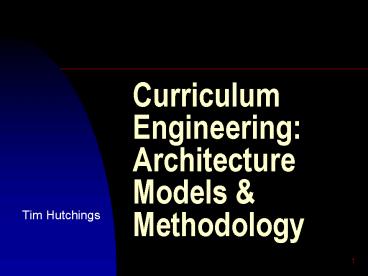Curriculum Engineering: Architecture Models PowerPoint PPT Presentation
1 / 25
Title: Curriculum Engineering: Architecture Models
1
Curriculum Engineering Architecture Models
Methodology
- Tim Hutchings
2
Introduction
- The aim of the seminar is to discuss research
into curriculum development - The objectives are to
- explain the need for a curriculum engineering
methodology - describe a prototype version of such a
methodology - explain how the methodology will be validated and
improved
3
Context
- Fees and Loans
- The Policy Minefield
- Institutions which succeed will be those that can
design, market, deliver and re-engineer their
curricula to meet and keep pace with the diverse
and rapidly changing aspirations of their clients.
4
Propositions
- At the strategic level of a scheme or award we
have - no accepted definition of a curriculum and
- no accepted theories of curriculum development.
- The result has been ad hoc curriculum development
5
Thesis
- At the strategic level of a scheme or award a
curriculum can be viewed as a complex example of
an information system - Ad hoc curriculum development can become
Curriculum Engineering if we are prepared to
learn from the field of Information Systems
Engineering
6
Methodology
- Foundations
- Philosophy
- Architecture
- Model
- Methodology
- Supporting Tools
7
Philosophy
- Typically Learning Outcomes rank below Modules
in the curriculum development hierarchy - Learning Outcomes should be considered key
elements of a logical definition of a curriculum
and as such should be drafted before any
consideration is given to module titles
8
Architecture
- The ANSI/X3/SPARC architecture has gained
widespread acceptance in the Information Systems
Engineering Field and forms the core of the
MERISE and SSADM v4 Methodologies
9
3-Schema Architecture
External External ... External Level View
1 View n external/conceptual mapping Concep
tual Conceptual Schema level conceptual/internal
mapping Internal Internal Schema Level
10
3-Schema Architecture
External Business Computer Multimedia Software
Level Information Studies Engineering Techno
logy external/conceptual mapping Conceptual Net
work of Learning Outcomes level conceptual/intern
al mapping Internal Module Definitions
11
Deliverables
- A Conceptual Schema in the form of a network of
learning outcomes - A set of External Views in the form of rationale
and core themes for each award - An Internal Schema in the form of a set of module
definitions
12
Models
- Monolithic
- Non-Monolithic
- Evolutionary
13
Monolithic Models
Analysis Design Implementation
14
Non-Monolithic Models
Analysis D1 D2 I1 I2
15
Evolutionary Models
Analysis Design Implementation
16
MethodologyOverview
Phase 1 External/Conceptual Design Phase
4 Phase 2 External Validation Internal
Design Phase 3 Internal Validation
17
Phase 1 Conceptual/External Design Scheme Aw
ard Rationale Rationale Core
Themes Core Themes Learning Learning
Outcomes Outcomes Rationalisation
Module Commission
18
Phase 2 Internal Design Assessment Criteria /
Evidence Assessment Activities Knowledge
Skills Supporting Materials
19
Phase 3 Internal Validation Packaging Quali
ty Review
20
Phase 4 External Validation Validation
21
Expected Benefits
- Ensures that the core themes (objectives) are
actually delivered - Optimum delivery efficiency
- Highly cohesive, loosely coupled modules
- Academic freedom and responsibility
- Avoids excessive reliance on a particular modular
framework
22
Possible Drawbacks
- Could be viewed as constraining by curriculum
developers
23
Data Dictionary
- Repository for Curriculum Engineering
Documentation - Version Control
- Impact Assessment
24
Curriculum Engineering Meta-Model
25
Validation and Improvement
- I am currently involved, with a number of
colleagues, in re-developing the BTEC Computing
Scheme using the methodology I have described. - I hope that we will all learn from the experience
and that subsequently we will be able to improve
the methodology based on practical experience

